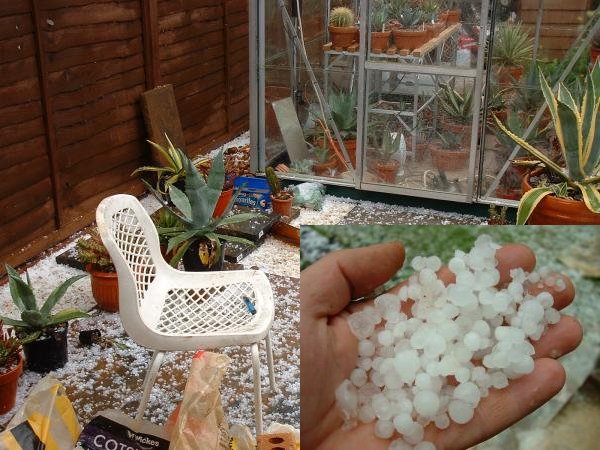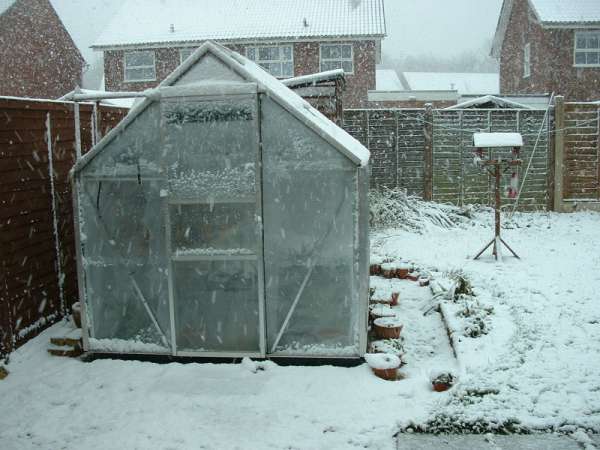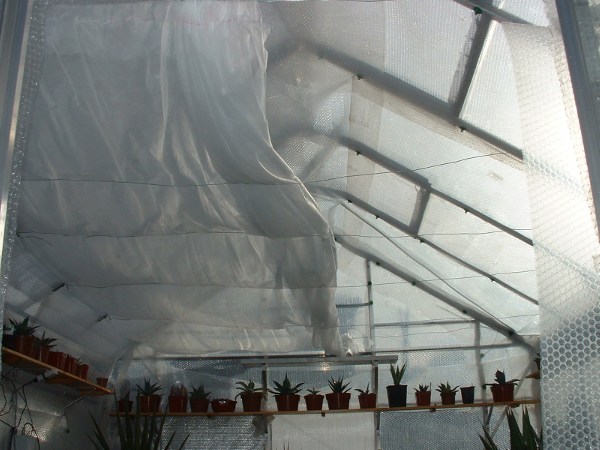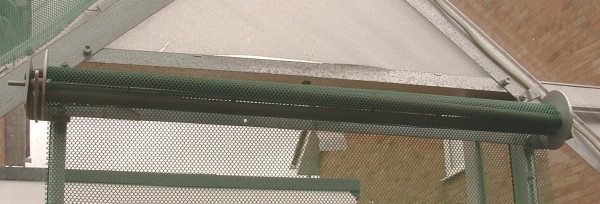Temperature and Climate.
Greenhouse Location.
The greenhouse should be sited where it gets maximum sunlight available along its longest side in winter to reduce heating costs.
Temperature.
The purpose of a greenhouse is to provide a shelter in which a suitable environment is maintained for plants. Solar energy from the sun provides sunlight and some heat to allow the growing season to be extended. For growing Agaves and other succulents in the UK the purpose for the greenhouse to provide protection from the worst the British climate has to offer. To succeed you must provide a method to control temperatures throughout the year. This is done by using heaters in conjunction with insulation in winter and good ventilation in summer. Many Agaves come from the slopes of mountains and can tolerate low temperatures but rarely put up with extended wet periods and low temperatures. During the height of summer, June-August, shading material can be placed on the outside south facing glass to of the limit temperature rises to acceptable levels in conjunction with adequate ventilation.
Expect the unexpected!

|
The pictures above were taken on 21st May 2005 where I would have reasonably expected the weather to be suitable for keeping plants outdoors. I was laying slabs for a new patio at the time. |
Heating.
To protect from frost, I aim to maintain an average temperature better than 3C over a 10 minute period. For plants that are sensitive, it is more economical to bring them indoors when adverse weather is forecast. It is important to monitor temperatures to ensure that you are not over heating, thus incurring unnecessary costs and for peace of mind that the thermostat on the heater is operating correctly.
The simplest form of heating is to use an electrical heater designed for such a purpose. Because these heaters at the lower end of the market are built to a price there is usually quite a lot of fiddling around with thermostat settings and testing temperatures before the optimum setting is found. I have noticed that some heaters with built in thermostats retain a microclimate of heat after they have reached the desired temperature and shut down. The actual temperature of the greenhouse can dip below acceptable levels before the thermostat switches on again. Increasing the thermostat setting results in the heater being on when it's not needed. Whatever make or model of heater you choose, always verify the temperature of the greenhouse is correct. One method to minimise this hysteresis effect of the built in thermostat is to place the heater close to the door where inevitable drafts will flush out the residual warm air from the heater enclosure.
The ideal heater will have a remote temperature sensor that could be placed in the optimum position and away from the heat source and direct sunlight.
In 2010, I set about constructing an electronic temperature controller that would offer better control of heating and fan control. The general set up and results of using the new controller can be seen on the electronic temperature controller pages together with details of current temperature monitoring arrangements.
Insulation.
The most common form of insulation is generically called bubble wrap. It is relatively cheap and easily installed as needed using plastic clips available at most garden centers. I usually put up two layers on the sides that get no winter sun. The first sheet goes onto the inside of the glass, the second sheet is then installed using the plastic clips. This gives an air gap of about 20 mm.
 |
Bubble Polythene provides Insulation. |
It is important to ensure that any condensation that occurs between the roof and the bubble wrap is directed into the drip channel or outside of the vertical insulation. Because insulation will cover up roof vents, it doesn't hurt to open the door for a few hours on sunny days.
To save heating costs, a layer of horticultural fleece can be suspended by attaching some galvanised wire across the eaves and then laying the fleece over the wires. The fleece can be spread out at night time to save having to heat the roof apex and can be recovered to one side during daytime.
 |
Horticultural fleece across the eaves. |
Ventilation.
The purpose of ventilation is to remove air from inside of the greenhouse and replace it with air from the outside. Ventilation can be achieved by natural processes or forced by using fans. During winter a heating system with adequate capacity is needed to maintain minimum temperatures. Even during the coldest part of the winter, when the heating system is running at full capacity, some ventilation is still required to prevent condensation. During summer the main purpose of a ventilation system is to prevent the air temperature inside the greenhouse from rising too high. The simplest form of ventilation in a small greenhouse is to use a device to open roof windows and louvres as the temperature rises. Opening the door will assist ventilation, but at the expense of allowing local wildlife to enter. This can easily be mitigated by contructing a roller blind made from polypropylene shading material to cover the door opening.
 |
Roller Blind - Door Screen. |




